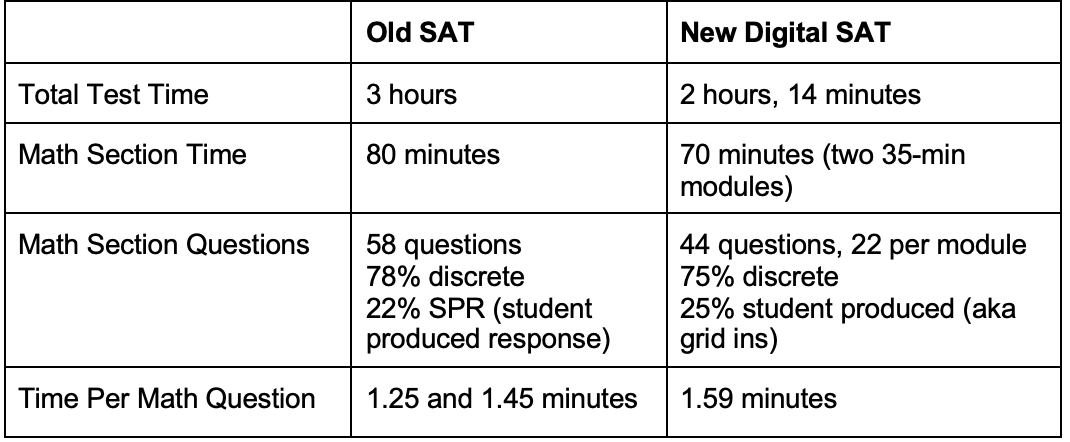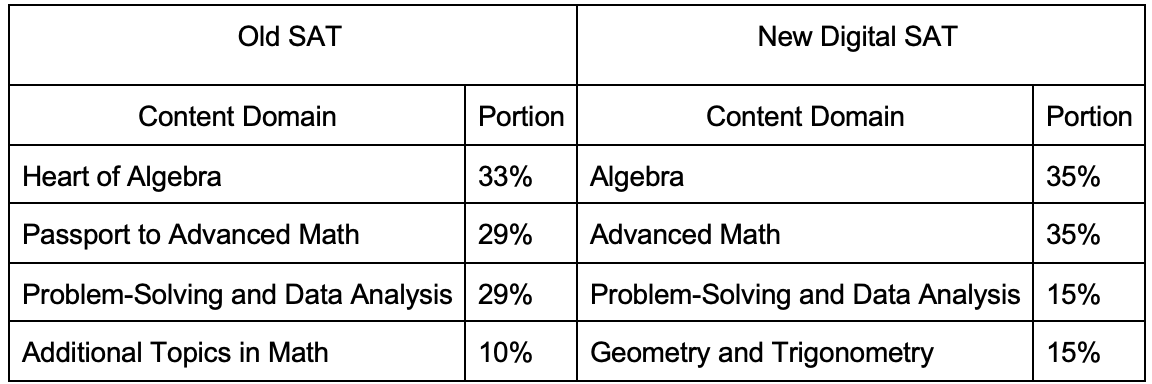What You Need To Know About The Digital SAT: Math
By Vickie Barone
Last year, the College Board made a big announcement: the SAT is going digital with a shorter and adaptive test that will be administered entirely on a computer (or tablet). Along with this move away from paper tests, the Digital SAT will look different in several other important ways. Though some of the information below applies to the new Digital SAT overall, I will primarily focus on changes to the SAT math section.
Digital SAT Math Section Highlights
Elimination of set-based questions. Every question will stand alone.
Shorter and more straightforward questions. Even word problems are less wordy!
Calculator use permitted throughout; built-in on-screen Desmos calculator provided.
Fewer questions, shorter test duration, more time per problem
Semi-adaptive testing. For each of the two main sections (math and verbal) all students get the same first module; what they get for the second module depends on their performance on the first one.
Scores align with the 1600 scale, but questions are weighted to reflect question difficulty.
Increased emphasis on geometry and trigonometry.
Timeline
The Digital PSAT/SAT timeline presents dilemma for the class of 2025 (rising juniors) in terms of when to test and what! If you really like the current paper SAT and want to stick with that, then you’ll have to test by December 2023, the last administration of the paper-and-pencil SAT. But, regardless, this fall (2023), you will be taking the new, digital PSAT. If, however, you are planning on testing in 2024, then you will have two choices: the ACT or Digital SAT.
Will I need to prepare differently for the digital SAT?
Yes and no. Yes, in that there are still some content changes (keep reading) and an entirely new test format that includes a new built-in calculator, Desmos. No, in that the new Digital SAT will largely feel the same as
the current SAT because both generally test the same knowledge and skills.
Digital SAT Test Format Changes: MATH
The most significant changes with the Digital SAT pertain to the format of the test rather than its content:
Multistage, adaptative testing
Digital tools
Pacing and scoring changes
Multistage adaptive testing? How does it work?
Of all the changes with the new SAT, the multi-stage adaptive nature of it is the hardest to explain and understand. Here’s how the College Board describes it:
“In a digital multistage adaptive SAT test, each test section (Reading and Writing, Math) is divided into two stages, called modules. Students answer a set of questions in the first module before moving on to the next. The questions in the second module are configured based on performance in the first module.”
So, if a student does well enough on the first module, their second module will be more difficult. If a student does not do as well on the first module, their second module will be easier. More advanced math students will see fewer easy questions, which they are likely to answer correctly anyway; less advanced students will see fewer difficult questions, which they are likely to miss anyway. So, the test design enables the College Board to assess students’ abilities with fewer questions. This may sound unfair but since the scoring is weighted by question difficulty, it evens out in the end.
Students will be permitted to skip around within a module but will not be permitted to skip between the modules. In other words, you must complete the first module before moving on to the second, and once done, students will not be allowed to return to the first.
You Will Want To Master The New Digital Tools
The test will give students the ability to flag questions they want to return to later, annotate within the questions, make notes for themselves, highlight keywords, or cross off answer choices as they go.
1) 100% Calculator use and a built-in (Desmos) graphing calculator
One of my favorite and biggest changes about the SAT is that students will be allowed to use a calculator throughout the entire math section. (You’ll also still be permitted to bring your own approved calculator, so no need to worry if you are more comfortable with your trusty TI-83 Plus!)
Daniel Kirchheimer, Director of Learning Systems Development for 1600.io observes “[the] College Board has made it clear with this SAT redesign that students are, for the first time, expected to demonstrate that they can rapidly and accurately solve math problems by leveraging the power of graphing calculators. So now students will be at a major disadvantage if they don’t become expert users of Desmos (or the equivalent handheld calculator) for solving SAT-style math problems.”
But that shouldn’t be a problem. Here’s what one 1600.io student said about Desmos:
“The digital SAT’s Desmos calculator is such a game changer; it almost feels illegal!”
Further, the integration of the Desmos calculator right into the fabric of the test gives every student access to the same quality calculator and removes the terrifying possibility of a student’s calculator batteries dying in the middle of the test. (That happens!)
Digital markup tools for questions and answers
Students will be able to use on-screen tools to flag questions they want to return to later, annotate within the questions, make notes, highlight keywords, or cross off answer choices.
Note: Students will be provided scratch paper to use if they choose to, and I will encourage my students to bring a pencil and use this tool. Most kids are used to doing math on paper and this will be especially important for multi-step problems.
Pacing & Scoring Changes
Shorter Sections, Fewer Problems, More Time Per Question
As with the current paper SAT, the Digital SAT will contain two math sections (now called “modules”). The two math modules include 44 questions to be completed n 70 minutes (vs. 58 questions in 80 minutes). Students will have more time per question, but please note that this doesn’t mean the section is easier.
Scores Available Sooner: Days Instead of Weeks
Whereas it takes 2-3 weeks to get scores back from the paper tests, it will only be a few days for the Digital SAT, enabling students to get performance feedback much sooner, which is always welcome!
Scoring Concordance with old SAT and the ACT
The Digital SAT will still be scored on the same/current 1600 scale. As with the paper SAT, the math score will be out of 800. The College Board conducted extensive research and testing to ensure a direct, one-to-one concordance between the current paper test and the new digital one. So, for example, 1250 on the Digital SAT corresponds to 1250 on the old paper SAT, making it familiar for students and colleges to use, with no conversions needed.
Test Format Summary
Old SAT vs. New Digital SAT Format, per College Board
Note: only students who do well enough on the first module to get into the harder second module will be able to achieve the highest scores.
Digital SAT Test Content Changes: MATH
Mostly algebra, more advanced math, less data analysis
No “set” questions (all standalone), less wordy word problems
No complex or imaginary numbers
Grid-in (student-produced responses) can be negative.
Math Question Topics: a small, but noticeable shift
As with the current sat, the new Digital SAT will still test students on their knowledge of high school math concepts through Algebra II and Trigonometry.
Old SAT vs. New Digital SAT Match Content comparison, per College Board
Because there are fewer questions on the Digital SAT, this does not mean more geometry and trig problems per test (still should be about six), but it does mean those six problems will represent a higher portion of the total questions. When preparing for the Digital SAT, students will want to do a full refresh of those most important geometry topics.
All standalone questions, less wordy word problems
Two major differences give the Digital SAT math section a welcome new feel. First, there will no longer be any multi-question “sets” based on one source of information (as featured regularly on the paper SAT). Each of the questions on the Digital SAT will be “discrete,” meaning they will have no relation to each other, and can all be answered independently, based on the information provided in the individual question.
Also, while word problems will still comprise about 30% of the section, they will be mercifully short. Students who are intimidated by a wall of text in a math problem (a common and frustrating experience for students taking the old paper SAT) will be thrilled by this update!
The new, shorter Digital SAT offers some great benefits, but don’t assume it’s an easier test!
Change can be scary sometimes, but this one doesn’t have to be! The Digital SAT features a lot of great updates that I think students will love. But remember, all these positive changes don’t mean the new SAT is a better or easier test. As always, students should do an ACT vs. SAT diagnostic and then prepare for the test that fits them best.
Need help deciding between the ACT or SAT or Digital SAT? We do a much more thorough and insightful comparison than the College Board, ACT org. and big-box tutoring companies.
getting started with the Digital SAT
Download College Board Bluebook App. You must register as a student to access it.
Learn/practice the Desmos on-screen calculator (Desmos videos, 1600.io guide)
If you will test on a tablet, consider getting a keyboard and mouse.
Practice going back and forth between the Desmos, your own calculator (if you want to use it) and scratch paper.
Practice using the annotation tools.
Math Resources
There are 4 digital practice tests available through the College Board’s Bluebook app. Additional tests will be released summer, 2023
Full length, linear NON-ADAPTIVE new SAT tests. There is some overlap with the digital adaptive ones, but not 100%.
Intro to the Desmos Calculator by Desmos




